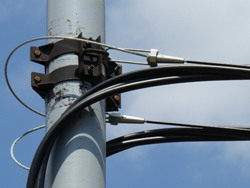Categories: Featured Articles » Novice electricians
Number of views: 19912
Comments on the article: 4
Cable wiring
 Among the variety of cable laying methods and wiring devices, stand out cable wiring. The need for it may arise if the surrounding building structures have a very complex terrain and are interspersed with large voids. This is possible, of course, only in production and storage facilities, as well as outdoors. After all, the internal walls of comfortable houses, offices and apartments are always more or less even, and you do not want to disfigure them with a string or cable with a bundle of wires, although the rules do not prohibit this.
Among the variety of cable laying methods and wiring devices, stand out cable wiring. The need for it may arise if the surrounding building structures have a very complex terrain and are interspersed with large voids. This is possible, of course, only in production and storage facilities, as well as outdoors. After all, the internal walls of comfortable houses, offices and apartments are always more or less even, and you do not want to disfigure them with a string or cable with a bundle of wires, although the rules do not prohibit this.
So, cable wiring - this, as the name implies, wiring for which the cable or string is made of galvanized or dyed wire rod. This is the fundamental difference between cable wiring and overhead power lines.
In overhead lines, the supporting element is the wire or cable itself. And, since the strength of the wire is clearly inferior to a steel wire or cable, it is impossible to provide a significant stretch to the air lines. And from here follow the restrictions on the maximum distance between two OHL supports and the measures that must be applied to eliminate overlapping of individual wires.
Cable wire lines are used for any spans in the composition of lighting circuits, outlet networks and trunk lines. The advantages of cable wiring are the ability to install in the space between two arbitrarily remote structures or buildings, the low cost of installation and the necessary fittings, a high level of fire and electrical safety, as well as the ability to use a support cable or wire to install not only cable, but also branch boxes or suspension fixtures.
The most effective sequence of installation of cable wiring is as follows:
1. We mount the cable on a string or cable using clamps or plastic ties, fix and disconnect the branch boxes, connect and fix the lamps.
2. We mount end fasteners for the supporting string on the supporting surfaces. Usually these are rings with anchor fasteners.
3. Carefully lift the cable / string and secure it along the span. It is advisable to use a lanyard to provide some tension. The wire is knitted in a heated state, and the cable is fixed with benders.
The diameter of the cable / wire for mounting the cable wiring is selected based on the length of the span and the mass of cables and fittings in the line. In practice, preference is given to a cable with a diameter of two to seven millimeters, as well as a wire with a diameter of 5-8 millimeters. The maximum permissible distance between two adjacent cable ties to the cable is 50 centimeters.
Despite the fact that the length of the spans of cable wiring is not limited by anything, it is necessary to arrange additional intermediate suspensions if possible. This is especially true in cases where the wiring is arranged indoors, there is a strong ceiling, and the span is very long. In open spaces with long lengths, lateral braces can be used to avoid swaying the line.
No special requirements are imposed on the cable wiring cable, since it does not bear any mechanical load. The main thing is that this cable meets the operating conditions. For example, for outdoor installation it is necessary to use a cable whose insulation is not afraid of moisture and has a high resistance to direct sunlight and.
The cable used as the supporting element must be solid along the entire span, connections are not allowed.Exceptions are possible only for sections of very long lengths in the presence of intermediate rigid mounts on any structures. The height of the cable electrical wiring in the room and on the walls should not be less than 2.5 meters, and above the driveways of cars - not less than 6 meters.
Alexander Molokov
See also at bgv.electricianexp.com
:
